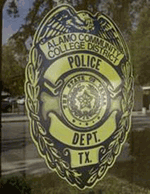
Think about the last time you felt a chill run down your spine because something felt very, very wrong.
From the time it takes you to walk from your vehicle to your classroom, could you remember what the last four people you passed on the way to class were wearing? Could you recognize the faces you saw from there to here? Could you describe in detail the characteristics of a suspicious situation, or give an accurate and specific recount of events after the fact?
In the event you are a witness to a crime, these are some of the things that authorities will ask you to do. Here at Palo Alto College, criminal activity is at a minimum, but it always helps to be prepared.
The campus police and Palo Alto staff devised an Emergency Response Manual to keep us safe and sound through events that might endanger our lives. The manual, which is a work in progress, is easily accessed through your student account here at Palo Alto College. In fact, it is right on the main web page under Campus News. What you’ll find is about 25 pages of who’s in charge, what they are responsible for and whom they should contact in case of emergency. A few scenarios are given that help focus on inclement weather, evacuation drills for fire, and even a fill-in-the-blank questionnaire for taking down the important details of a bomb threat. Names and phone numbers of whom to call in the event of an emergency are also included. One of those names is Robert Garza, director of Distance and Extended Education and Community Outreach.
“We have improved on the old Alamo Community College Safety Plan to make it more up to date, and specifically better suited for Palo Alto College,” said Garza. “On the old plan, even some of the phone numbers were wrong.”
But, what about other elements of danger? That’s what the ACCD police are for.
Officer Ruben Tello, one of the officers assigned to Palo Alto College, said, “Our primary goal is to protect life.”
Tello said that in the event of a situation resembling the tragedy at Virginia Tech, they would do their best to handle the situation and keep those not immediately involved out of harm’s way.
“We are authorized to do what we must to neutralize any active threat to the student body,” Tello said.
What if there is not enough time to call the campus police for help? What steps can we take as students to keep ourselves out of trouble? Let’s assume that we are faced with a harmful situation, and we are without the immediate benefit of campus security. What should students, faculty members and staff do to protect themselves?
Chip Bohls, a second degree brown belt from Steven Kern’s Iron Dog Academy of Mixed Martial Arts, said, “You don’t need to be a practiced martial artist to protect yourself. The first thing we have to do is start paying attention. We have to make ourselves aware of who could be a potential threat. It doesn’t take more than a quick glance around to make sure we are safe. Most of the time just being aware of our surroundings is enough to keep us out of trouble.”
Bohls offered three pieces of advice for staying out of harm’s way.
“First, try not to find yourself alone in a questionable situation. Say a young woman is about to walk from her classroom to her car. It would be best to walk with a friend, since there is safety in numbers. If no one else is around, ask a security guard or policeman to escort you.”
“Second,” Bohls said, “start carrying around a whistle. It’s a great tool for attracting attention. Any would-be attacker will not want any witnesses, which are sure to come investigate the sound of someone screaming their head off and blowing a panic whistle.”
Last, Bohls tells us that we should carry our keys in our hand well before we get to our vehicle.
“Forget about carrying around one of those little spray cans of pepper spray. It’s not strong enough to completely disable an experienced fighter. It is likely that you will only make an attacker angry if you spray him or her. Keys can be used as a scratching or stabbing weapon to disorient your attacker long enough for you to break away and escape. At the very least, you will have your keys handy when you get to your car. Digging around in your purse or pockets provides enough of a distraction for an attacker to strike.”
To contact Palo Alto’s Campus Police, call (210) 921-5213, or drop by the Student Center, Rooms 127A and 127B.